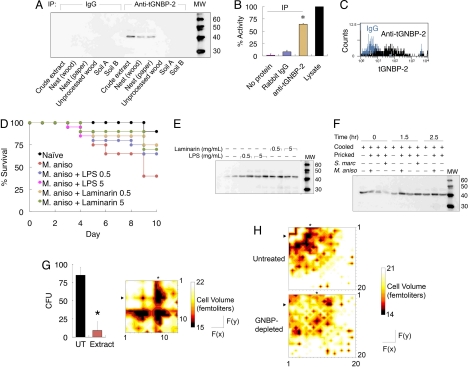Fig. 2.
tGNBP-2 is an effector β(1,3)-glucanase induced by pathogenic patterns. (A) Immunoprecipitation of tGNBP-2 from termite extracts, nests, unprocessed wood, and soils A and B sampled from different locations. (B) β(1,3)-Glucanase activity of termite immunoprecipitate isolated by rabbit IgG or anti-tGNBP-2 (*, P < 0.05 vs. no protein and rabbit IgG). (C) Expression of tGNBP-2 on hemocyte surface, measured by flow cytometry. (D) Survival of termites infected with Metarhizium anisopliae (M. aniso) following immunization with LPS or laminarin at either 0.5 or 5 mg/mL along a course of 10 days (mean of 2 groups, n = 12/group; all immunized termite groups were P < 0.05 vs. M. aniso only, and P > 0.05 vs. naïve termites with the exception of 0.5 mg/mL LPS). (E) tGNBP-2 expression after exposure of termites to either LPS or laminarin at either 0.5 or 5 mg/mL (left and right lanes in each sample represent two independent repeats). (F) Expression of tGNBP-2 after termite infection with M. anisopliae (M. aniso) or Serratia marcescens (S. marc). Cooled only (cooled) or cooled and pricked (pricked) termites are shown as controls. (G) Effect of crude termite extract on conidial growth (in CFUs) on potato-dextrose agar plates (*, P < 0.05 vs. untreated conidia) (Left). Cytotoxicity map of fractionated termites on M. anisopliae conidia measured by cell volume in femtoliters (Right). F(x),F(y) represent fractions 1–13 on either axis. The tGNBP-2+ fraction is marked by an arrowhead; asterisks mark putative antimicrobial peptides. (H) Loss of cytotoxicity after depletion of tGNBP-2 by antibody precipitation. F(x),F(y) represent fractions 1–20 on either axis.

